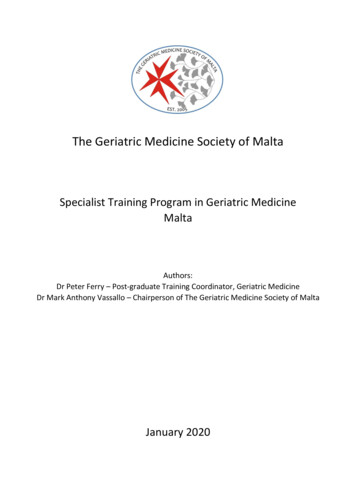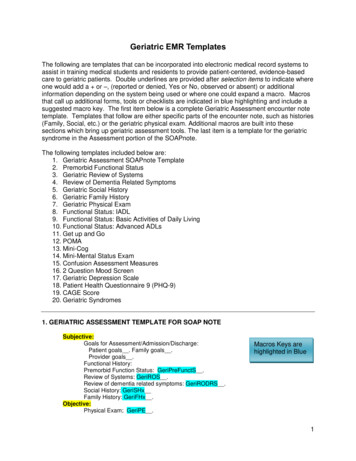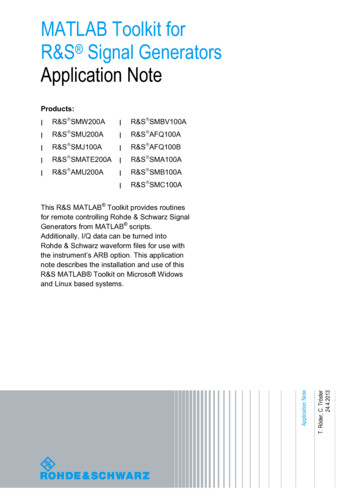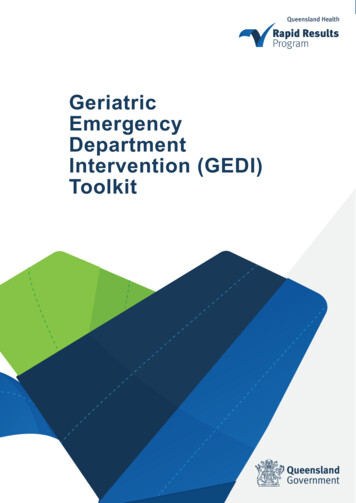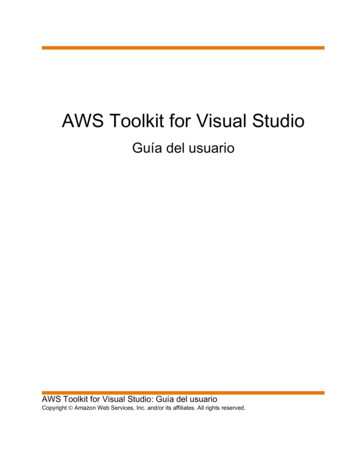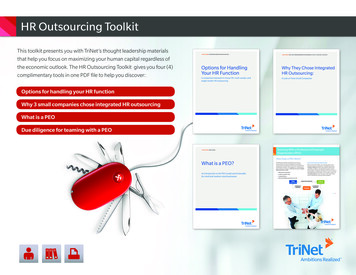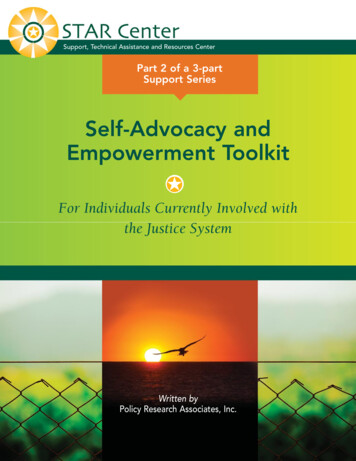
Transcription
GERIATRIC TOOLKITDeveloped by Baylor University Louise Herrington School of Nursing, partially funded by the Texas HigherEducation Coordinating Board Nursing Innovation Grant ProgramINTRODUCTIONThis toolkit is intended to provide resources that may behelpful in preparing students in providing care for olderadults. This work was developed by Baylor Universityand supported in part by a grant from the Texas HigherEducation Coordinating Board (THECB). The opinionsand conclusions expressed in this document are those of the author(s) and do not necessarily represent theopinions or policy of the THECB.1
CONTENTSIntroduction . 1Geriatric Nursing Competency Tool . 3Instructions . 3Geriatric Nursing Competency Tool . 3Resources . 4General Resources . 4Physical Care of older adults . 4Skin Integrity. 4Elimination . 4Nutritional Status . 5Pain . 5Sleep . 5Cognitive Function of older adults . 5Safety of older adults . 6Restraints . 6Mistreatment . 6Fall Prevention . 6Medications. 6Communication with older adults. 6Barrier . 6Decision-Making . 7Care Coordination of older adults . 7Delegation . 7Referrals . 72
GERIATRIC NURSING COMPETENCY TOOLINSTRUCTIONSThe purpose of the Geriatric Nursing Competency Tool is to evaluate an undergraduate pre-licensure nursingstudent’s proficiency in providing care for older adults. This tool is designed to be used in the clinical setting(i.e. acute care, acute, or long-term rehabilitation, assisted living, etc.) by a clinical instructor or preceptor.There are three identified proficiency levels:1) Able to perform skill with prompting and assistance from preceptor2) Initiates without prompting and safely performs skill with assistance from preceptor3) Initiates and safely performs skill independently.The levels are intended to indicate the progression in the nursing student’s ability to provide care for olderadults in these competency areas: Physical care of older adultsCognitive function of older adultsSafety of older adultsCommunication with older adultsCare coordination of older adultsThe student must show proficiency in all identified capacities of care related to assessment, intervention,teaching, and evaluation in the competency area to receive a single proficiency level.GERIATRIC NURSING COMPETENCY TOOLDownload Blank Geriatric Nursing Competency ToolDownload Geriatric Nursing Competency Tool with InstructionsIn the tool, each competency area has examples related to assessment(s) and intervention(s) in bullet pointlists. These examples may vary based on the care setting and the individual circumstances of older adults thusare not intended to be an exhaustive list.3
RESOURCESGENERAL RESOURCESTry This: Series: Assessment tools for best practices of care for older adultsSPICES: An efficient instrument for obtaining the information necessary to prevent health alterations in olderadults patient. SPICES is an acronym for the common syndromes of the elderly requiring nursingintervention:S is for Sleep DisordersP is for Problems with Eating or FeedingI is for IncontinenceC is for ConfusionE is for Evidence of FallsS is for Skin BreakdownThe Portal of Geriatrics Online EducationOlder Adult Focus: Competency development and education for health professionals Subject IndexThe Hartford Institute for Geriatric NursingHealthinAging.orgU.S. National Library of MedicineNational Association for Geriatric EducationAdvancing Care Excellence for Seniors (ACES): Strategies for faculty to incorporate into student learningexperiences:PHYSICAL CARE OF OLDER ADULTSSkin IntegrityThe Braden ScaleEliminationUrinary Incontinence Assessment in Older Adults: Part I - Transient Urinary IncontinenceUrinary Incontinence Assessment in Older Adults: Part II - Established Urinary IncontinenceNursing care plan for constipationPreventing Constipation in older adults4
Nutritional StatusMini-Nutritional Assessment Short-Form (MNA -SF)Alcohol use and screening for older adults:Preventing aspiration in older adults with dysphagiaNutrition for Older AdultsPainPain assessment for older adultsGeriatric Pain AssessmentPain management in older adultsSleepThe Pittsburgh Sleep Quality Index (PSQI): Used to measure the quality and patterns of sleep in older adultsEpworth Sleepiness Scale (ESS): Used to measure average daytime sleepiness and differentiate betweenaverage sleepiness and excessive daytime sleepiness that requires interventionCOGNITIVE FUNCTION OF OLDER ADULTSThe 3 D's of Confusion (PowerPoint)Geriatric Depression Scale (GDS)The Impact of Event Scale: An instrument to measure the subjective response to a specific traumatic event inthe senior population; not diagnostic for PTSDConfusion Assessment Method for the ICU (CAM-ICU): For all older adults admitted to the ICU in order topromptly identify any potential delirium and prevent negative outcomesUnderstanding the Dementia Experience. Thoughtful Dementia Care BookThe Mini-Cog: A 3-minute screening tool to detect cognitive impairment in routine visits and hospitalizationsMontreal Cognitive Assessment: A quick screening tool for mild cognitive impairment and early Alzheimer'sdementia that assesses the domains of attention and concentration, executive functions, memory,language, visuoconstructional skills, conceptual thinking, calculations, and orientationConfusion Assessment Method (CAM): A standardized tool that enables non-psychiatrically trained cliniciansto identify and recognize delirium quickly and accurately in both clinical and research settingsScreening for Delirium, Dementia and Depression in Older Adults: Nursing Best Practice Guidelines5
SAFETY OF OLDER ADULTSRestraintsRestraint Free CarePromoting Safety: Alternative Approaches to the Use of Restraints: From Nursing Best Practice GuidelinesMistreatmentElder mistreatment assessmentLegal Rights of Older Adults, Elder AbuseNational Center on Elder AbuseElder abuse in the United States: A teaching strategy for nursesFall PreventionFalls PreventionHendrich II Fall Risk Model: In acute care, a best practice approach, quick to administer, that provides adetermination of risk for falling based on gender, mental and emotional status, symptoms of dizziness,and known categories of medications that increase riskFalls Efficacy Scale-International (FES-I): A short, easy-to-administer tool that measures the level of concernabout falling during social and physical activities inside and outside the home, whether or not the personactually does the activityFrailty Index for Elders (FIFE): Developed to assess for frailty risk in older adults using items collected in existingnursing datasetsNursing Best Practice Guidelines: Prevention of Falls and Fall Injuries in older adultsMedicationsAmerican Geriatrics Society (AGS) Updated Beers Criteria: Include three main categories: (1) potentiallyinappropriate medications and classes to avoid in older adults; (2) potentially inappropriate medicationsand classes to avoid in older adults with certain conditions that the drugs listed can exacerbate; and (3)medications to be used with considerable caution in older adultsCOMMUNICATION WITH OLDER ADULTSBarrierHearing screening in older adultsSensory Changes6
Vision, communication when impairedDecision-MakingDecision-makingEnd-of-Life Decision-Making for Older Adults: Competent and Compassionate CareUnderstand Situational Decision MakingCARE COORDINATION OF OLDER ADULTSDelegationModified Caregiver Strain Index (MCSI): A 13-question tool to screen for caregiver strain with long-termfamily caregivers related to care provisionAssessing family preferences for participation in care in hospitalized older adultsPreparedness for Caregiving Scale: A caregiver self-rated instrument of eight items that asks caregivers howwell prepared they believe they are for multiple domains of caregivingReferralsKatz Index of Independence in Activities of Daily Living (Katz ADL): An instrument to assess functional status asa measurement of the client's ability to perform activities of daily living independentlyLawton Instrumental Activities of Daily Living Scale (IADL): An instrument to assess independent living skillsTransitional Care Model (TCM): Identifies patients who are high risk for poor outcomes in the transition fromhospital to homeCoordinating and Managing Care during Transitions Among Care Settings7
Developed by Baylor University Louise Herrington School of Nursing , partially funded by the Texas Higher Education Coordinating Board Nursing Innovation Grant Program . INTRODUCTION This toolkit is intended to provide resources that may be helpful in preparing students in providing care for older adults.
